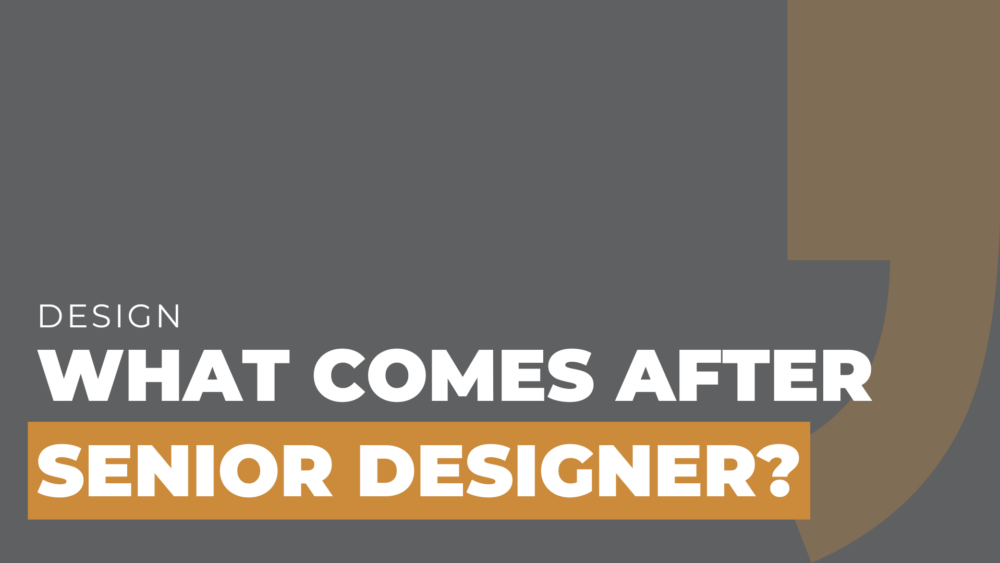You’ve made it.
Senior Designer.
A title that means you’ve earned your stripes, gained experience, and can handle almost anything your boss or client throws your way.
But now what?
What comes after senior designer is the natural question once the shine of the title wears off.
You’ve mastered execution. You’re mentoring juniors. You’re leading projects.
But you’re also feeling ready for more—more influence, more decision-making power, and maybe even the challenge of becoming a creative director.
Let’s map out your career options from here.
Whether you stay on the traditional track or try something a little different, there are smart ways to level up.
The Graphic Design Career Ladder
To see what’s next, you’ve got to understand the stages behind you.
Here’s a quick look at how the graphic design career path typically evolves.
Junior Designer: Learning the Ropes
Most start here.
You’re working under senior creatives, building files, mockups, decks, or marketing pieces.
You’re learning how to apply design principles in the real world and survive your first few rounds of edits without rage-quitting.
Mid-Level Designer: Owning the Work
Now, you’re trusted with full projects.
You’ll get more face time with clients. More responsibility. More say.
And you’ll sharpen those soft skills: presenting your work, collaborating across departments, and thinking more strategically.
Senior Designer: Leading the Craft
This is where your expertise shows.
You’re not just executing—you’re leading.
You mentor others, guide projects, and influence design direction.
But after a while, the ceiling shows itself.
And you start asking: what now?
What Comes After Senior Designer?
There are a few typical paths forward—each pulling you closer to strategy, leadership, and vision.
Let’s break them down.
1. Lead Designer
Lead Designers often bridge the gap between creatives and management.
You’re responsible for the success of entire projects, not just the design files.
You’ll set timelines, oversee reviews, and collaborate more with other departments.
You may still design sometimes, but your main focus shifts to direction and team coordination.
2. Design Director
This role goes deeper into leadership.
As a Design Director, you lead the design department—not just the work, but the people.
You’re responsible for hiring, mentoring, and maintaining creative quality.
You’ll work closely with other department heads and often report directly to executive leadership.
Design Directors don’t just know good design—they know how to align that design with brand strategy and business goals.
They set the bar.
They protect the brand.
They lead with vision.
This position also tends to be a stepping stone toward the creative director role.
Becoming a Creative Director
A creative director isn’t just a more senior designer.
They’re a creative strategist, brand steward, and team leader rolled into one.
They’re responsible for all visual and verbal brand expressions—ads, campaigns, packaging, social, you name it.
They manage people, budgets, timelines, and ideas.
They pitch work to clients and leadership, sell ideas internally, and make sure everything aligns with the brand story.
If you’re energized by the idea of influencing entire brands (not just designing them), this might be your next move.
Alternate Routes: Freelance or Studio Life
Not everyone wants to lead a team or manage a department.
If autonomy sounds more appealing, freelancing or starting a design studio may be the better fit.
Freelancing
Freelancers choose their clients, projects, and schedule.
You’ll have control—and responsibility.
You’re the designer, project manager, bookkeeper, and new business team.
You’ll learn fast, and you’ll wear all the hats.
But if you value flexibility, it’s worth considering.
Starting a Design Studio
If you’ve got an entrepreneurial itch, this path lets you build your own creative culture.
You’ll get to shape the brand, set your standards, and lead a team your way.
You’ll also deal with business decisions, staffing, operations, and sales.
It’s a bold move—and it requires more than great design chops—but it can be incredibly rewarding.
Fears and Worries
Starting your own studio sounds exciting, but it’s normal to feel nervous.
You might wonder:
- Where will I find clients?
- How do I handle all the business stuff?
- What if the money runs out?
There’s also the worry of getting stuck—juggling too many roles and feeling overwhelmed.
But here’s the thing: every big move feels scary at first.
The key is to plan smart, ask for help when you need it, and take it one step at a time.
Because on the other side of those worries? Freedom, creativity, and a business that’s all yours.
Questions to Ask Yourself Before You Move
- Do I enjoy managing people and helping them grow?
- Am I excited by the strategy side of design?
- Do I want more ownership, even if it means less designing?
- Or do I want more freedom and variety, even if that means less security?
Your next step should align with what energizes you.
Because that’s what keeps you growing.
At The End Of The Day
What comes after senior designer depends on you.
You can pursue leadership roles like Lead Designer, Design Director, or creative director.
You can step off the ladder and go freelance or build your own studio.
You can even mix paths over time—because your career is not a straight line.
The only constant is change.
What matters most is that your next move plays to your strengths, stretches your abilities, and supports your vision for your life.
And when you’re ready to make that leap, we’re here for you.
Ready to Design What’s Next?
Whether you’re climbing the ladder or carving your own path, MOCK, the agency is here to make you look good doing it.
We partner with internal marketing teams, in-house designers, and creative leaders to deliver exceptional work—fast, strategic, and stress-free.
Let us take something off your plate—and make it look fantastic while we’re at it.
- Website: https://mocktheagency.com/
- Phone: 470-225-6814
- Email: hello@mocktheagency.com
- Address: 247 14th St NW, Atlanta, GA 30318


Comments are closed.